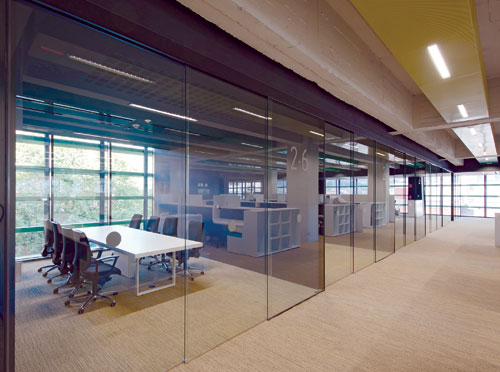Interior Sliding Frameless Glass Doors Make a Clear Contribution to LEED
Learning Objectives:
- Discuss the latest technology in interior sliding glass doors and partitions and their relation to green building.
- Compare tempered and laminated glass in terms of safety and sustainable design.
- Identify where interior glass doors contribute to LEED points.
- Explain how interior glass can increase human productivity and well-being while reducing energy consumption.
Credits:
There is nothing like glass to give a clean, crisp, contemporary visual experience to a building and to raise its sustainability quotient. Increasingly, interior glass doors are part of the picture, as they create a distinctly modern look while allowing visibility and natural daylight to flow through the space, promoting a sense of openness and connection with the surroundings. New-generation frameless and sliding glass doors are particularly popular in Europe and are now gaining traction in the U.S. Architects are finding that in offices, hotels, and other commercial settings, these glass sliding door options offer a host of benefits not only in achieving good design consistent with today's flexible work and life styles, but in meeting advanced green building goals. This article will discuss the latest in interior sliding glass door technology in terms of its contribution to the U.S. Green Building Council's Leadership in Energy and Environmental Design (LEED) ratings and the other advantages it offers both users and owners of commercial properties.
Interior Sliding Frameless Glass Door Options
In the past few years, there has been both a great demand for frameless sliding glass doors in commercial projects and a large number of offerings for sliding glass door systems. Today, architects can choose from a variety of applications from a single sliding door to specialized systems such as self-closing, telescopic, or corner simultaneous opening doors to enhance the working or living environment in spaces both large and small.
Single Sliding Glass Doors Along Existing Wall
Options here include barn doors with surface-mounted or recessed tracks. The tracks can be recessed into the ceiling for a clean-looking application, or left exposed for a more contemporary look. Pocket doors are also very popular for a more conventional design. Nowadays, tracks can not only be easily recessed and still allow access to the system without disruption to ceiling or finished soffit, but also be left exposed with a compact 2-inch track that contributes to a minimalist design.
A self-closing feature can be added, allowing the door to slowly close by itself after opening it manually. This helps prevent strong glass impact and thus glass breakage when the doors are closed or opened with force.
 |
Interior sliding glass doors add to a building's sustainability and contribute to LEED points. Photo courtesy of Klein USA, Inc. |









